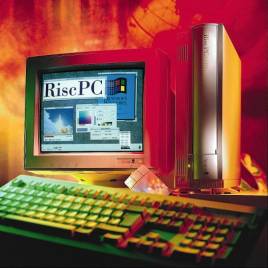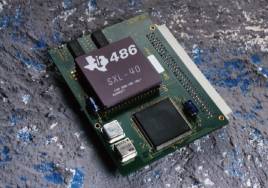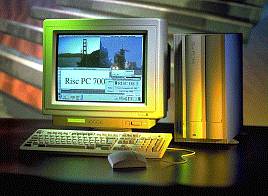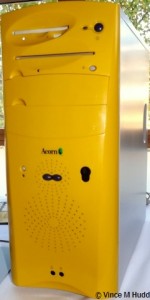And, for many people, you’re still going strong.
The RiscPC was the most powerful computer Acorn ever put into production, and it was officially launched twenty years ago today, on Friday, 15th April, 1994. according to Acorn’s April 1994 Developers’ Newsletter and the date of their announcement on usenet. RISCOSitory takes a look back over its twenty year (so far) life.

Although Acorn’s Developers’ Newsletter cites 15th April as the key date, it appears there were a series of launch events over the course of three days, with one the day before and one the day after (which seemingly inspired Drobe and IconBar to celebrate the RiscPC’s 10th birthday on the 16th April, rather than the 15th). Those launch events were held at The Production Box, a conference and event suite at The Cumberland Hotel, near London’s Marble Arch, and attended by dealers and developers, all eager to see the new machine in its release form.
The RiscPC was Acorn’s next generation ARM computer, and marked a major architecture change for their hardware, the first significant change in several years, and in the period running up to the launch Acorn had been holding ‘new architecture’ meetings for developers, inviting them to visit Acorn House – Acorn’s home at that time in Vision Park, Cambridge – to test their products, in order to ensure that there would be as much third party software as possible that would run on the machine out of the box, when the public was able to buy it.
It was already known that a new Acorn computer was coming, but it was only known by its codename, Medusa, which led to discussion and speculation about what it might be called when officially launched, with some people pointing out that Acorn had already dropped the name Archimedes for new computers some years earlier, and were now likely to continue their use of a ‘yawn-yawn letter number combination‘ – with one commenter even suggesting the name A6000, which neatly follows the A5000 name and ties in with the ARM610 processor that was to feature in the new machine, and also leads the way for a future machine to be called the A7000; wrong about the name for the new machine, but successfully predicting what a future machine would be called!
The culmination of some two and a half years of development, according to Acorn User magazine, at launch the RiscPC’s specification included the ARM610 processor, which was an ARMv3 architecture CPU running at 30MHz, and featuring a Memory Management Unit (MMU) on board – replacing the separate memory controller used on Acorn’s older computers – as well as a 4kB cache. Significantly, rather than being mounted directly on the motherboard, the processor was actually mounted on a daughterboard, connected to the main board via a DIN socket, meaning it could easily be swapped out for a replacement processor, such as the ARM710 when it became available – which Acorn suggested would be in the final quarter of 1994, but in reality the 40MHz replacement for the ARM610 didn’t arrive until July, 1995.

Even more significantly, there wasn’t just one socket for the processor card, but two, so that users could have a second processor in the computer, with the first to be available being a 24/33MHz 486SX PC Card – also expected in the final quarter of the year, but eventually slipping back to the first quarter of 1995, and becoming more widely available soon after that, with the first 10,000 cards having been distributed by mid-1995 and the next batch not expected until around August. The second processor could access all the memory and input/output facilities of the computer, and when the accompanying software was launched the RiscPC behaved exactly like a typical 486 PC, making it two computers in one. Towards the end of 1995, and first shown at that year’s Acorn World show at the Wembley Exhibition Centre in October, second generation PC cards became available, ranging from a 66MHz 486DX2 at £292.58 plus VAT to a 100MHz 5×86 at £586.33 plus VAT, with a discount of £100 offered to owners of existing cards.
The RiscPC could address up to 256MB of memory via two SIMM sockets, although the configurations initially sold didn’t come with anywhere near that amount, and Acorn’s announcement also suggested that ‘current technology’ meant expansion was actually limited to 128MB. Separate video RAM of up to 2MB was also supported, which allowed full 24-bit colour or, trading colour-depth for pixels, a resolution of up to 1600×1200 – a major step forward for Acorn, with the screen memory on previous computers taken from their main memory, which meant users were doing a three-way trade between colours, resolution and memory; a four-way trade if speed is considered, but that went hand in hand with memory, so the new separate VRAM had a speed benefit as well.
The machine came with a hard disc as standard, with two of the initial configurations including a 210MB drive, doubled up to 420MB in the third, and that hard drive was connected to the main board via IDE, and there was a second socket and a 5.25″ drive bay available for the user to expand the computer’s storage capabilities, with an optional CD-ROM drive was touted as one possible use – and, of course, there was a 3.5″ floppy disc drive, supporting ADFS format discs of up to 1,600kB.
There was also room for two single-width expansion cards in the RiscPC, which could accept those designed for existing Archimedes computers, but which benefited from significant improvements for new cards: DEBI (DMA Extended Bus Interface) allowed cards to directly access main system RAM, without assistance from the CPU, and featured a 32-bit data bus size, and the processor space available to cards was increased to 16MB. This EASI (Extended Acorn System Interface) space also allowed data held in ROM or RAM on an expansion card to be accessed directly, rather than being accessed in chunks of 4kB, as previously.
Thanks to the new modular case, designed by Allen Boothroyd of Cambridge Product Design, expansion possibilities didn’t stop at extra memory, a bigger hard drive and/or a second drive, and two expansion cards. The case was designed for both ease of access and expansion, with a very easy to remove top, and a central section – known as a slice – that could be built on with further slices, with more slices meaning more opportunities for expansion, up to a maximum of six – although one of the features of the Acorn World Show, which took place at the Wembley Exhibition Centre from 28th-30th October, 1994, were a number of RiscPCs that went beyond that number, including Peter Bondar’s infamous ‘Rocket Ship’ RiscPC, which featured a toaster in the topmost slice.
The operating system was RISC OS 3.5, which came on two ROM chips occupying 2MB in total, and was essentially a version of RISC OS 3 designed to both support and take advantage of the new hardware, with a new interface for selecting screen modes by colour-depth and resolution, rather than using a ‘mode number’, an improved appearance for the desktop, and more.
And all of this could be in the end users’ hands – or, rather, on their desks – in one of three configurations:
- 2MB RAM, no VRAM, 210MB hard disc – £1,249 plus VAT
- 4MB RAM, 1MB VRAM, 210MB hard disc – £1,399 plus VAT
- 8MB RAM, 1MB VRAM, 420MB hard disc – £1,699 plus VAT
All three came with a 14″ monitor as standard with an optional upgrade to a 17″ monitor costing an extra £400 plus VAT, and later in the year Acorn reviewed this policy and introduced the ‘Acorn Enthusiasts Scheme’, under which it was possible to buy single RiscPCs without a monitor, allowing people to use something of their own choosing. An extra ‘slice’ for the RiscPC was priced at £99 plus VAT, as was the PC Card (if ordered with a computer), and the VRAM cost £129 plus VAT for 1MB, or £199 plus VAT for 2MB.
The general public would have seen the announcements in the latter half of April, either online or in the press (to whom Acorn previewed the RiscPC as early as January), and would have had their first chance to look at the machine ‘in the flesh’ from Friday, 22nd April, 1994 at the Acorn User Spring Show at Harrogate – though keen-eyed members of the public may have already seen the new case design, without realising what it was they were looking at, at the previous year’s Acorn World, as well as at BETT in January of 1994, where a black version of the case could be found at the centre of Acorn’s ‘Future Technology’ showcase.
The Harrogate show also featured in Acorn’s launch plans, and they had hoped to have several hundred RiscPCs for sale at the event but, sadly, this proved impossible because, although the machines were built, the ARM610 processors had yet to be delivered – so the only RiscPCs at the show were those on exhibitors’ stands.

The next model in the series, the RiscPC 700, was launched a little over a year later, in mid-1995 – by which time Acorn had reportedly sold around 25,000 RiscPC 600s – and, at the same time, the RiscPC 600 was slightly improved, with the new specification featuring a 33MHz ARM610 processor in place of the old 30MHz version. The new RiscPC 700, meanwhile, featured a 40MHz ARM 710.
Both machines featured full 16-bit sound as standard, and an updated version of the operating system – RISC OS 3.6 – which saw the size of the ROMs increased to 4MB from RISC OS 3.5’s 2MB. Benefits of the new version of RISC OS included an improved FileCore, allowing the system to address hard discs of up to a theoretical 4GB, a significant increase on the previous limit of 512MB, and it also saw some of the supplied Apps included in ROM once again.
With the new range came new prices, and a RiscPC 600 with 4MB RAM (no VRAM) and a 425MB hard disc was priced at £1,148.09 plus VAT, including a high resolution 14″ monitor, while the closest equivalent RiscPC 700 – the same amount of RAM and hard disc space, but with 1MB VRAM – was priced at £1,360.85 plus VAT, and a version with all three doubled was priced at £1,692.77 plus VAT. A 17″ monitor could be ordered in place of the 14″ monitor for an extra £280 plus VAT, and there was an optional IDE CD-ROM drive available for an additional £111 plus VAT.
The next major upgrade to the RiscPC came with the StrongARM processor. The result of a collaboration between Digital and ARM, in the early stages of development the processor was expected to produce 200 Dhrystone II MIPS at 200MHz, and would be compatible with the instruction set used in the existing ARM processors used by Acorn, making it a good candidate for use in RiscPCs. The processor’s core was based around a Harvard style architecture, with separate data and instruction caches, while the previous ARM processors used a Von Neumann style architecture, and it also featured a pipeline increase from three to five stages, amongst other improvements – all of which would contribute to a notable speed increase – and it was hinted at the Acorn World show in October of 1995 that a StrongARM upgrade could appear in Summer 1996.
The first prototype RiscPC using an experimental StrongARM card, with a first release of the prototype silicone, was powered up on 26th March, 1996 at 11:12am, and produced an initial benchmark of 147,000 Dhrystones. After some internal testing and modification to the system software, the processor achieved an internal clock speed of 228MHz, reaching 290,000 Dhrystones running RISC OS. StrongARM was demonstrated to the RISC OS world at the first ever Wakefield Show, held on 19th May at the Cedar Court Hotel – just a little over a month after the RiscPC’s second birthday – with two versions present; a 169MHz first iteration processor, and a 200MHz sencond iteration version, the latter in a perspex case so spectators could see the board and RISC OS ROMs.
General availability of the StrongARM upgrade, which would come with RISC OS 3.7, was expected in September that year, and the price was set at £249 plus VAT, or £99 plus VAT for anyone ordering a StrongARM upgrade at the same time as purchasing a RiscPC. For those not ordering it in advance, the card went on general sale at 1996’s Acorn World event, which took place at the Wembley Exhibition Centre and ran from 1st to 3rd November, and repeating the run up to the launch of the RiscPC itself, in the period before the StrongARM became available developers were able to visit Acorn to test their products on StrongARM-based RiscPCs.
An updated, 200MHz StrongARM version of the RiscPC was announced around March, 1995, with four models in the range, two with and two without a CD-ROM drive. A 4MB machine was priced at £1,150, and a 10MB machine at £1,450, and the CD-ROM equipped equivalent machines were priced at £50 more – and Acorn said that once stocks of ARM710-based RiscPCs were depleted, they’d be replaced with the equivalent StrongARM-based models.
A 233MHz version was planned for launch at the 1997 Acorn World Show, which ran from 31st October to 2nd November, at the Wembley Conference and Exhibition Centre, but due to sales being better than expected, stocks of the 200MHz computers were exhausted, so the faster version began shipping earlier.

Acorn World 1997 was also the show at which Acorn debuted the prototype RiscPC II, intended for launch the following year. The computer, which was also known as Phoebe 2100 and later officially called the Phoebe RiscPC II, had been talked about by Peter Bondar the year before. A later, more complete version of the planned new machine – including the famous yellow-fronted case design – was previewed at the following year’s Wakefield Show, which took place on 16th and 17th May, 1998, at the Thornes Park Athletics Stadium, having been postponed from its original planned weekend of 25th and 26th April, specifically to “enable Acorn to demonstrate the next generation of RiscPC”.
Advance orders were taken taken for £100 towards the full price of £1,499 plus VAT, without a monitor, with an expected launch date of ‘around September’ and general availability at the 1998 Acorn World Show, scheduled for 16th to 18th October, at London’s Docklands Arena – the advertising for which had also been heralding it as Acorn’s 20th birthday party. As the show drew nearer, however, it emerged that the machine wouldn’t be on sale, and only pre-production models would be at the event. The computer was to be supplied with a 6.4GB hard drive, a 32 speed CD-ROM drive, 4 PCI sockets, 32MBof RAM, and 4MB of VRAM which, unlike the VRAM of its predecessor, was a fixed amount.
On September 17th, 1998 – a date that came to be known as Black Thursday in the RISC OS world – Acorn unexpectedly closed its workstations division, shedding some 70 staff, and the looming show was ‘postponed’. Then CEO, the recently-appointed Stan Boland, claimed Acorn’s future depended on thin client terminals and digital TV technology, so the company needed to focus on those two markets; production of computers was a technical and financial ‘distraction’. It soon emerged that Acorn was still willing to manufacture components for products that already existed, provided there was demand for them, and a number of interested parties began looking into acquiring rights from Acorn, including a ‘steering group’, headed up by Peter Bondar, with the aim of forming a new company for the purpose, and Castle Technology, who were hoping to take over dealer distribution of Acorn’s desktop products.
In the end, the deal was struck with Castle, who became Acorn’s official distributor, forming a new company, Castle Technology Ltd, or CTL. The RiscPC, therefore, was still to be manufactured and sold.
Soon after, the steering group – now minus Peter Bondar, but with Uniqueway’s Paul Middleton working with R-Comp’s Andrew Rawnsley instead – began negotiating with Acorn for the rights to the operating system itself. Just before Christmas, 1998, an announcement appeared on Acorn’s website stating that RISC OS 4 would be available by the end of January, 1999, whereas unofficial estimates suggested that date was unlikely, and that much more work was needed to bring it to a release state, with the likely explanation for the announcement being that it had been put on the website on an unlinked page, ready for the operating system’s eventual release, and had become linked in error. Meanwhile, the steering group’s negotiations had proven successful, leading to a new company – RISCOS Ltd – being formed to license and develop the operating system, with the goal of making it available as an upgrade.
RISCOS Ltd’s website went live a few months into 1999, with adverts appearing in the press around the same time advertising RISC OS 4 for £120, referring people to the website for ordering instructions. The operating system would be supplied on replacement FlashROMs, but would include support for intermediate upgrades that could be supplied on disc and soft-loaded. Key features of RISC OS 4 included support for larger hard discs, the ability (via a new disc format) to use long filenames, and more. The new operating system received a press showing on 1st July, 1999, and it was first shown to the public at the South East Show, at the St Albans Arena, on 3rd July – and all existing orders had been fulfilled by the end of the month.
Castle, meanwhile, announced they had negotiated a licence to continue manufacturing the RiscPC themselves, saying that the StrongARM RiscPC, now known as the RiscPC233, would be available again from June 1999 – and that RISC OS 4 would be offered to customers as a choice “with all its speed, usability and visual improvements” – with prices starting from £749 plus VAT and going up to £1,149 plus VAT, depending on the model ordered.
The next major milestone in the RiscPCs life came when Castle announced, at a press briefing in May, 2000, that they were releasing a new ‘Kinetic RiscPC’ with prices starting at £1,173 including VAT. An upgrade would also be available for £299 for existing RiscPC owners, who could trade in their existing StrongARM card for a discount.
The Kinetic upgrade took the form of a replacement processor board, which replaced the existing processor card in a RiscPC, and featured a 233MHz StrongARM, and either 64MB or 128MB of super-fast SO-DIMM DRAM on board. The card also included a 66MHz memory bus (compared with the RiscPC’s 16MHz memory bus) and RISC OS 4.03 on a flash-ROM, which was copied into the on-board memory at start-up and run from there. The overall result – much as when the StrongARM upgrade was released – was another significant speed increase, and a new lease of life, for the RiscPC.
As well as a speed boost, May also saw the RiscPC receive a major upgrade to its graphics capabilities, when John Kortink’s Windfall Engineering released the ViewFinder graphics card. Taking the form of a single height DEBI card and blanking plate, ViewFinder housed an ATI graphics card, which would normally be found in PCs of the time. Offering ‘true colour’ (32-bit) resolutions of up to 1600×1200 at 82Hz, the ViewFinder was priced at Dfl 800 including VAT. Over the next few years, upgraded versions of the card became available, with newer and better graphics cards.
A programme of upgrades to the operating system commenced the following year, when RISCOS Ltd announced a subscription-based scheme, called RISC OS Select. Subscribers to the scheme would receive up to three CDs per year, on which they would find both beta software and official release versions, with beta components on one release expected to become official releases on the next. Select subscriptions would cost £105 per year for existing RISC OS 4 users, and for those who did not yet have the latest version of the operating system it would cost £179 initially, which would get them RISC OS 4 as part of the deal. The first version of RISC OS Select shipped in May, 2002.
The following year saw the RiscPC’s production come to an end. On 11th November, 2003, Castle Technology Ltd announced that, once current supplies had been exhausted, they would no longer be manufactured – after some nine and a half years; an impressive production life for any computer. Castle’s Jack Lillingston said of the RiscPC in the announcement “The demise of the Risc PC is the end of an era. It has served the RISC OS market for an incredibly long time and proved a wonderful tool for those who appreciate RISC OS systems” and that “the Risc PC will be greatly missed for what it has allowed users to achieve during its long lifetime.”
The end of production, however, didn’t change the fact that the RiscPC was still in widespread use and, in June 2004, RISCOS Ltd released RISC OS Adjust – the latest version of Select, RISC OS 4.39, but committed once again to ROM – with prices varying depending on which version of RISC OS customers were using; £130 including VAT for people still using RISC OS 3.x in their RiscPCs, £115 including VAT for those using RISC OS 4, and £95 including VAT for Select subscribers, with a further discount of £10 for each year they had been subscribed. The Select scheme also continued, with new versions of the operating system branded as RISC OS Six, which was announced on 18th October, 2006.
Bringing the story almost right up to date, the 2013 Midlands Midsummer MUG Show, which was held at St John’s Church Hall, Kenilworth, on 13th July, 2013, saw RISC OS Open Ltd release of RISC OS 5.20 on ROM for IOMD-based computers. The RISC OS 5 fork of the operating system originally appeared in Castle’s IyonixPC, and this was the first version to be released for the RiscPC.
Even more recently, when RISCOSitory ran its first awards poll at the end of 2013, that poll was combined with a survey. The results of the survey were finally counted and published at the start of April this year, and it revealed that 19.73% of those who took part – almost one in five – were using a RiscPC as their main RISC OS computer.
The RiscPC, now twenty years old, is very definitely still going strong.


